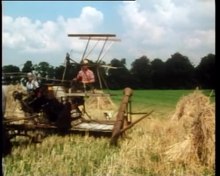Mower binders
A harvester (also binding mower , commonly known binder ) is an agricultural machine for the harvesting of grain .
Based on the invention of the mechanical knotter in 1857 by John Francis Appleby , Charles Withington developed the mower binder in the USA in 1872 . He takes over the mowing of the grain as well as the bundling and binding of the stalks into sheaves . The mower ties the tied sheaves down on the field.
The first machines only tied the grain previously deposited in piles in the field. Due to the high grain losses, they could not prevail and were only sold in the USA.
As a further development, the sheaves in the mower binder are tied immediately after they have been mowed with a cutter bar . The mower binder therefore needs a reel to push the grain into the cutter bar and to put it down in an orderly manner after the cut. A head divider (cone or rotating pointed snail) prevents losses at the edge of the uncut grain field. Crop lifters ensure that stored grain can also be harvested with fewer grain losses. A mechanism then bundles the loose grain and wraps a string around it to then knot it. The bound sheaves are first on the field manually to several upright squatting together to redried or to avoid to contact with the ground transportation of the ears. The sheaves were loaded later by hand or with fork on cars, for threshing transported or stored in a barn to make it work in a poor time with the flail to thresh . Later this work was done by combine harvesters .
The mower was driven by the chassis, i. H. a wheel with a particularly easy-grip iron profile drove all devices with a gear. The required pulling force was applied by two to four horses, oxen and later by tractors. Later the devices were powered by a power take-off shaft.
Since the cutter bar does not work in the tracks of the draft animals or the tractor, a track width first had to be mowed by hand (scythe) and tied by hand.
Historically, the mowing binder has followed manual mowing with sickle , sight or scythe and manual tying. It was especially widespread in Germany after the Second World War until the end of the 1960s, when it was replaced by the combine harvester .
literature
- Wüst-Nachtweh: Agricultural engineering . Berlin 1902.
- Walter Renard : The knotting process on the tie mower. Stuttgart 1940.


